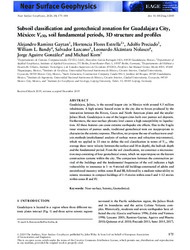Subsoil classification and geotechnical zonation for Guadalajara City, México: Vs30, soil fundamental periods, 3D structure and profiles
Ramírez Gaytan, Alejandro
Flores Estrella, Hortencia
Preciado, Adolfo
Bandy, William L.
Lazcano, Salvador
Alcántara Nolasco, Leonardo
Aguirre González, Jorge
Korn, Michael
DOI: https://doi.org/10.1002/nsg.12085
Persistent URL: http://resolver.sub.uni-goettingen.de/purl?gldocs-11858/8531
Persistent URL: http://resolver.sub.uni-goettingen.de/purl?gldocs-11858/8531
Ramírez Gaytan, Alejandro; Flores Estrella, Hortencia; Preciado, Adolfo; Bandy, William L.; Lazcano, Salvador; Alcántara Nolasco, Leonardo; Aguirre González, Jorge; Korn, Michael, 2020: Subsoil classification and geotechnical zonation for Guadalajara City, México: Vs30, soil fundamental periods, 3D structure and profiles. In: Near Surface Geophysics, Band 18, 2: 175 - 188, DOI: 10.1002/nsg.12085.
 |
Dokument öffnen: |
Guadalajara, Jalisco, is the second largest city in Mexico with around 4.5 million inhabitants. A high seismic hazard exists in the city due to forces produced by the interaction between the Rivera, Cocos and North American plates and the smaller Jalisco Block. Guadalajara is one of the largest cities built over pumice soil deposits. Furthermore, the near‐surface phreatic level causes a high susceptibility to liquefaction. All these features can cause extreme earthquake site effects. Due to the fragile inner structure of pumice sands, traditional geotechnical tests are inappropriate to characterize the seismic response. Therefore, we propose the use of surface wave analysis methods (multichannel analysis of surface waves and refraction microtremor), which we applied in 33 sites to define the soil classification in terms of VS30 (the average shear wave velocity between the surface and 30 m depth), the bedrock depth and the fundamental period. From the soil classification, we construct a microzonation map consisting of four geotechnical zones, which we superimpose on the known construction systems within the city. The comparison between the construction period of the buildings and the fundamental frequencies of the soil indicates a high vulnerability to resonance in 1‐ to 4‐storied old buildings constructed of adobe and unreinforced masonry within zones II and III, followed by a medium vulnerability to seismic resonance in compact buildings of 1–4 stories within zone I and 1–12 stories within zones II and IV.
Statistik:
ZugriffsstatistikSammlung:
This is an open access article under the terms of the Creative Commons Attribution License, which permits use, distribution and reproduction in any medium, provided the original work is properly cited.

